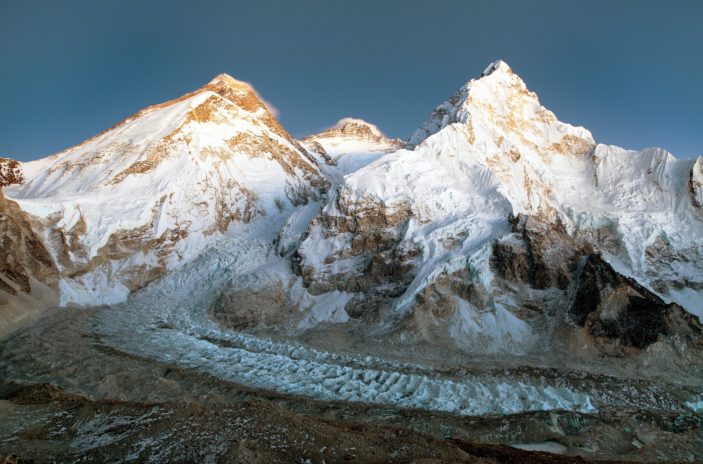Tiny Creatures Help Regulate Earth’s Environment
With all the heat generated about global warming (or climate change) one might think that only humans affect Earth’s environment. After all, who else drives cars? Or dramatically alters the local landscape? Or burns fossil fuels to run businesses, produce power, and operate myriad electronic and mechanical devices? While these activities reside almost exclusively in the human arena, Earth’s habitability depends on far more drastic changes caused by other life.
A growing body of evidence shows that tiny ocean creatures significantly affect the motion of 75 percent of Earth’s surface through their role in mixing the oceans’ nutrients. A couple of recent examples––two algae––demonstrate how life may have maintained and increased Earth’s habitability and lend credibility to the proposition that microorganisms have a large impact on the planet.
Since Earth cooled down after its initial formation stages and the tumultuous late heavy bombardment––a period not conducive to life––the average global temperature has remained within 10°C of the current value. Yet, after life appeared major astronomical and global changes have occurred, but have not produced devastating results. Tiny swimmers may be responsible.
The Sun Grows Brighter
During Earth’s early history, the Sun emitted 15–25 percent less light than today. Since that time, its output steadily increased (and will continue to do so in the future). This extra energy should have incinerated Earth’s surface. However, the composition of the planetary atmosphere also changed over time such that less-effective greenhouse gases replaced more effective ones. Specifically, the methane (produced by microorganisms) dominated the greenhouse effect on the early Earth, but now carbon dioxide (generated by a wide variety of life) dominates. The growth and weathering of continents coupled with the continual change of the kinds, sizes, and quantities of life present throughout Earth’s history precisely balanced the effects of the growing solar luminosity.
The Glaciers Grow Larger
Roughly 2.5 billion years ago, photosynthetic organisms appeared in abundance throughout Earth. Because of these organisms’ large populations, they changed the atmosphere dramatically by producing a permanent oxygen component. While this change paved the way for more advanced life, the rapid increase in oxygen quickly (on geological timescales) reduced the greenhouse heating caused by the atmosphere. Specifically, the oxygen reacted with the methane to produce carbon dioxide and water. The reduction in greenhouse heating likely led to a glaciation event covering the whole Earth.
Biological organisms Stir the Oceans
Not only did microorganisms play a critical role in altering Earth’s atmosphere and surface to maintain a stable temperature, but also new research provides evidence that they also stir the nutrients through the ocean. To understand the importance of this mixing, consider what happens to a candle placed inside a closed container. The candle rapidly consumes all the oxygen in its environment and the flame extinguishes. (If you drop a jar containing a lit candle, the flame will burn out before the jar falls more than 4–5 feet.) Similarly, without mixing, bacteria and other single-celled organisms will consume all the nutrients in a region of water and perish.
Two studies published in the Physical Review Letters analyze how two particular organisms, Volvox carteri and Chalmydomonas reinhardtii, affect the requisite stirring. (Physics published a publicly accessible overview of the two articles.1) Volvox, a larger multicellular spherical alga, swims by a flagellary beating of a thousand cells comprising its surface. In contrast, Chalmydomonas, a smaller unicellular alga, swims with breast-stroke-like motions from two flagella.
One study sought to understand how the swimming motions of the two organisms impacted the flow of fluid, both close by and farther away. Prior to this research, scientists had thought that all organisms affected the surrounding environment in a similar fashion, with only small differences due to size and concentration. Instead, the researchers found that each motion caused a markedly different effect in both regions.2 Specifically, swimming by the larger of the two algae caused fluid to move more effectively at greater distances, similar to particles falling through water under the force of gravity.
The second study looked only at Volvox and found even more complexity in how the swimming motions alter the flow of fluid around it. After confining the microorganisms in a thin liquid film, researchers used a high-speed camera to record the dynamics over a single swim stroke. The results showed that the fluctuations from the time-averaged flow for a single stroke are strong and even result in flow reversals.3
What does all this mean? First, it means that different organisms affect their local environment in a far more complex fashion than originally thought. This complexity permits a greater capacity to communicate and coordinate motion among microorganism colonies. Not only will these motions stir nutrients through the oceans, but also different mixes of microorganisms will circulate seawater in different ways. Both of these effects maintain the habitability of the oceans and provide for a diverse range of water habitats. Thanks to these efficient, long-standing climate regulators, humans benefit from knowledge of their work and its results as we manage Earth’s resources.
Endnotes
- David Saintillan, “A Quantitative Look into Microorganism Hydrodynamics,” Physics 3, no. 84 (October 11, 2010): doi 10.1103/Physics.3.84.
- Knut Drescher et al., “Direct Measurement of the Flow Field around Swimming Microorganisms,” Physical Review Letters 105, no. 16 (October 15, 2010): 168101.
- Jeffrey S. Guasto, Karl A. Johnson, and J. P. Gollub, “Oscillatory Flows Induced by Microorganisms Swimming in Two Dimensions,” Physical Review Letters 105, no. 16 (October 15, 2010): 168102.






